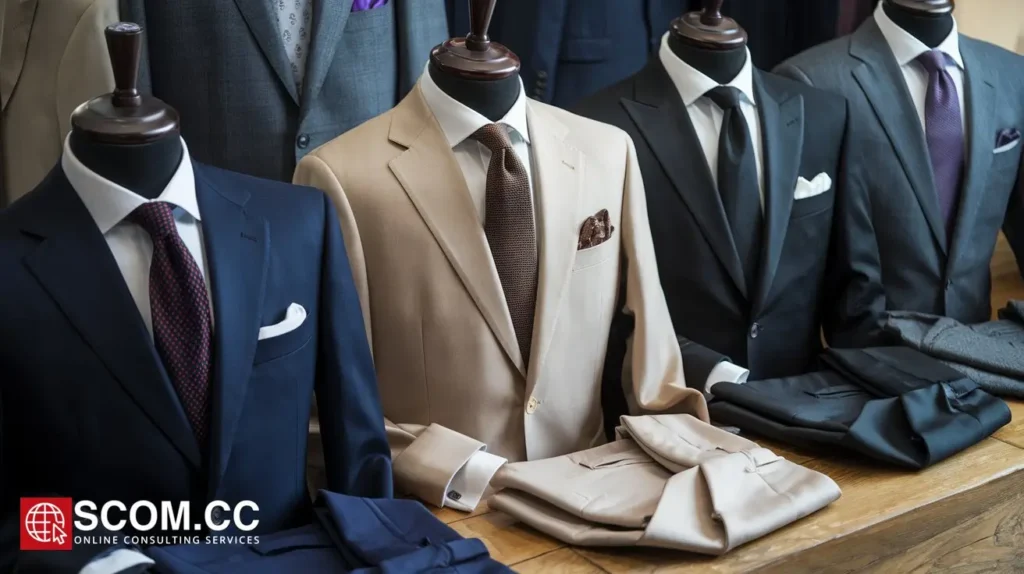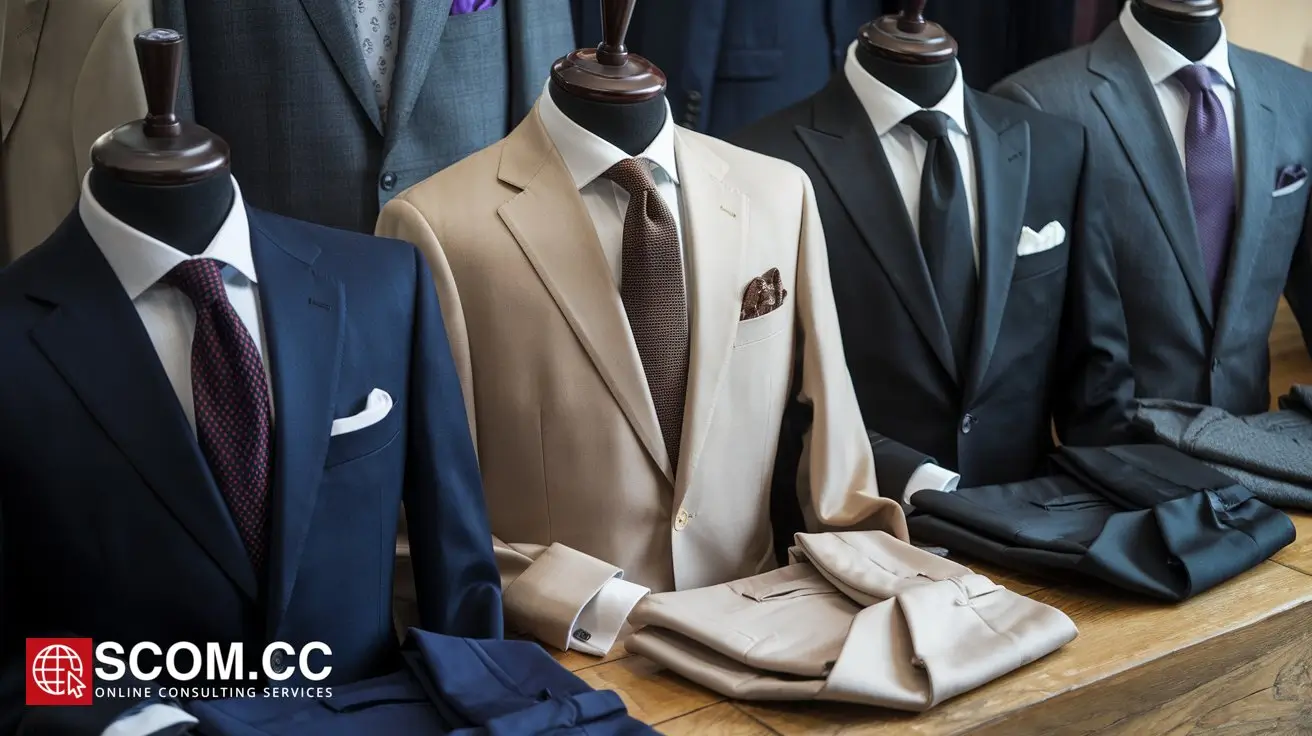The Ultimate Guide to Choosing Suit Colors and Patterns

- The Ultimate Guide to Choosing Suit Colors and Patterns
- Understanding Suit Colors
- Choosing Suit Patterns
- Matching Colors and Patterns
- Occasion and Suit Choice
- Personal Style and Fit
-
FAQ
- 1. What are the best suit colors for a job interview?
- 2. Can I wear a black suit to a wedding?
- 3. What patterns are appropriate for a business setting?
- 4. How can I incorporate patterns into my suit without overdoing it?
- 5. What are some good suit colors for summer events?
- 6. Are earth tones suitable for formal occasions?
- 7. How should I choose a suit pattern based on my body type?
The Ultimate Guide to Choosing Suit Colors and Patterns
Selecting the right colors and patterns for a suit can significantly enhance your style and ensure you make a memorable impression. From classic hues to bold patterns, the choices you make can reflect your personality and suitability for various occasions. This guide explores the essential aspects of choosing suit colors and patterns to help you achieve a sophisticated and stylish look.
Understanding Suit Colors
Suit colors play a crucial role in determining the overall impact of your outfit. Choosing the right color can affect how you are perceived and ensure that you are appropriately dressed for different events.
Classic Suit Colors
Navy Blue
Navy blue is a timeless and versatile color that works well for both formal and casual settings. It exudes professionalism and confidence, making it an excellent choice for business meetings and interviews. Navy suits are also versatile enough to be worn to weddings and other semi-formal occasions.
Charcoal Gray
Charcoal gray is another classic color that provides a sleek and sophisticated look. It is ideal for formal events and business environments. This color pairs well with a wide range of shirts and accessories, offering flexibility in styling.
Black
Black suits are traditionally associated with formal events, such as black-tie occasions and evening wear. They convey elegance and are perfect for making a bold statement. However, black suits are less versatile for daytime or casual settings.
Seasonal and Trendy Colors
Light Gray
Light gray suits are excellent for spring and summer, offering a fresh and airy look. They are versatile and can be dressed up or down depending on the occasion. Light gray suits work well for weddings, garden parties, and daytime events.
Earth Tones
Earth tones like brown, olive, and beige are becoming increasingly popular for their relaxed and sophisticated appearance. These colors are suitable for casual and semi-formal events and can provide a unique alternative to traditional suit colors.
Pastels
Pastel-colored suits, such as light blue or soft pink, are perfect for spring and summer events. They offer a stylish and modern look, ideal for weddings or social gatherings where a lighter, more playful appearance is desired.
Choosing Suit Patterns
Patterns can add character and depth to a suit, allowing you to express your individuality and stand out from the crowd. Here are some popular suit patterns and how to wear them effectively:
Solid
Solid suits are the most versatile and timeless option. They provide a clean and classic look that is suitable for almost any occasion. Solid colors offer flexibility in pairing with patterned shirts and accessories.
Pinstripe
Pinstripe suits feature thin, vertical lines that add a subtle yet distinctive element to the suit. This pattern is often associated with business and formal settings, as it conveys authority and professionalism. Pinstripes can also elongate the appearance of the wearer, making them a flattering choice.
Checkered
Checkered patterns come in various styles, including windowpane, gingham, and plaids. Each type offers a unique look:
- Windowpane: Large, grid-like checks that add a bold and modern touch to the suit. Ideal for making a statement at semi-formal or social events.
- Gingham: Smaller, uniform checks that provide a casual and relaxed appearance. Suitable for less formal settings or weekend wear.
- Plaid: A classic pattern that varies in size and color. It can add a traditional and stylish element to the suit, appropriate for both formal and casual occasions.
Houndstooth
Houndstooth is a distinctive pattern featuring a broken check design that resembles a dog's tooth. This pattern adds a touch of elegance and is suitable for both formal and casual settings. It works well for colder seasons and adds texture to the suit.
Double-Breasted vs. Single-Breasted Patterns
Both double-breasted and single-breasted suits can feature patterns. Double-breasted suits with patterns often convey a more formal and distinguished look, while single-breasted suits with patterns can be versatile and suited for various occasions.
Matching Colors and Patterns
Effectively matching colors and patterns is essential for a cohesive and stylish look. Here’s how to achieve a balanced appearance:
Coordinating with Shirts and Accessories
When wearing a patterned suit, opt for a solid-colored shirt to avoid overwhelming the look. Similarly, choose accessories such as ties and pocket squares that complement the suit’s pattern without clashing.
Color Harmony
Ensure that the colors of the suit, shirt, and accessories harmonize well. For instance, a navy suit pairs well with a light blue or white shirt and can be accentuated with a complementary tie. Avoid excessive matching; instead, aim for a balanced and coordinated appearance.
Seasonal Considerations
Consider the season when choosing suit colors and patterns. Lighter colors and patterns are suitable for warmer weather, while darker, richer colors and textures work well for cooler seasons.
Occasion and Suit Choice
The occasion plays a significant role in determining the appropriate suit color and pattern. Here’s a guide to help you choose based on different events:
Business and Professional Settings
For business and professional environments, opt for classic colors like navy, charcoal gray, or black. Solid colors or subtle patterns, such as pinstripes, are ideal for maintaining a professional appearance.
Weddings and Formal Events
For weddings and formal events, consider traditional colors like navy or charcoal gray. Patterns such as windowpane or houndstooth can add a touch of sophistication. Light gray or pastel colors are suitable for spring and summer weddings.
For casual and social settings, experiment with earth tones, lighter colors, or unique patterns. Checkered or plaid suits can offer a stylish and relaxed appearance for less formal occasions.
Personal Style and Fit
Ultimately, your suit should reflect your personal style and fit well. Choose colors and patterns that resonate with your taste and ensure the suit complements your body shape. Investing in proper tailoring can enhance the overall look and ensure the suit fits comfortably.
By carefully selecting suit colors and patterns based on the factors outlined above, you can achieve a polished and stylish appearance that suits any occasion. Whether you prefer classic shades or bold patterns, the key is to make informed choices that reflect your personality and enhance your overall look.
Summary Table
| Aspect | Details |
|---|---|
| Classic Suit Colors | - Navy Blue: Versatile, professional, ideal for business and formal events. - Charcoal Gray: Sleek, sophisticated, suitable for business and formal occasions. - Black: Traditional for black-tie and formal events, bold and elegant. |
| Seasonal and Trendy Colors | - Light Gray: Fresh, ideal for spring and summer, versatile. - Earth Tones: Relaxed, suitable for casual and semi-formal events. - Pastels: Stylish for spring and summer, playful and modern. |
| Suit Patterns | - Solid: Classic, versatile, suitable for any occasion. - Pinstripe: Subtle vertical lines, ideal for business and formal settings. - Checkered: Includes windowpane, gingham, and plaid, adding character. - Houndstooth: Elegant, textured, suitable for formal and casual settings. |
| Matching Colors and Patterns | - Shirts and Accessories: Match patterned suits with solid shirts, coordinate accessories. - Color Harmony: Ensure colors complement each other. - Seasonal Considerations: Light colors and patterns for warm weather, dark for cooler seasons. |
| Occasion and Suit Choice | - Business/Professional: Classic colors like navy, gray, or black, solid or subtle patterns. - Weddings/Formal Events: Traditional colors, patterns like windowpane or houndstooth, light gray or pastels for spring/summer. - Casual/Social: Earth tones, lighter colors, unique patterns like plaid or checkered. |
| Personal Style and Fit | Reflect personal taste, ensure a good fit with proper tailoring. |
FAQ
1. What are the best suit colors for a job interview?
For a job interview, opt for classic and professional colors such as navy blue or charcoal gray. These colors convey confidence and professionalism. Avoid overly bright or flashy colors to maintain a formal and serious impression.
2. Can I wear a black suit to a wedding?
A black suit can be worn to a wedding, especially if it is a formal or black-tie event. However, for less formal or daytime weddings, consider lighter colors such as navy blue or light gray to suit the occasion better.
3. What patterns are appropriate for a business setting?
In a business setting, solid colors or subtle patterns such as pinstripes are most appropriate. These options provide a polished and professional appearance without being too distracting.
4. How can I incorporate patterns into my suit without overdoing it?
To incorporate patterns into your suit without overdoing it, pair a patterned suit with a solid-colored shirt and accessories. Opt for subtle patterns like checkered or pinstripe for a sophisticated look.
5. What are some good suit colors for summer events?
For summer events, choose lighter colors such as light gray or pastel shades. These colors are refreshing and suitable for warm weather, providing a stylish and comfortable look.
6. Are earth tones suitable for formal occasions?
While earth tones are generally more casual, they can be appropriate for semi-formal or business casual events. For strictly formal occasions, opt for traditional colors like navy blue, charcoal gray, or black.
7. How should I choose a suit pattern based on my body type?
For a more slim or tall frame, patterns like pinstripes or windowpane can enhance your appearance. For a shorter or broader frame, checkered or solid colors can create a balanced look. Ensure the suit fits well and complements your body shape.

To explore more about tailoring, visit our Blog of Tailoring. If you have any questions or need assistance, go to our contact page. Additionally, you can find more information about tailoring and consulting at this tailoring and consulting portal.

Leave a Reply